
 HMS WIVERN
HMS WIVERN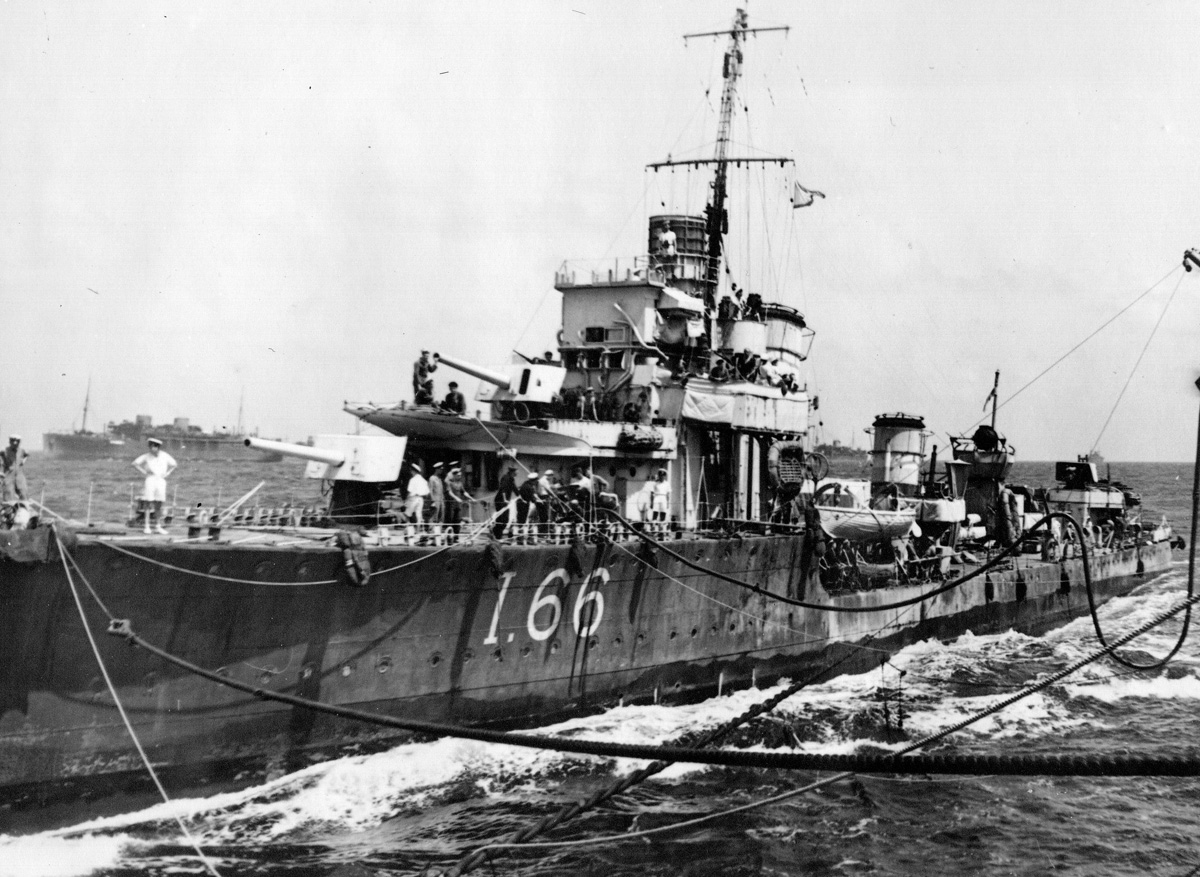
Commanding Officers
| Lt Cdr John I. Hallett (28 Nov, 1919 – 13 July, 1920) Lt Cdr Ralph G. H. Izat (13 July, 1920 – 4 May, 1922) Lt Cdr Cecil H. J. Harcourt (April, 1922 – 27 June 1925) Lt Cdr Philip H. Calderon (27 June, 1925 – July, 1927) Lt Cdr Edward Lyon Berthon (July 1927 - June 1928) |
Lt.Cdr. Walter Evershed, RN (31 Jul 1939 - 17 Jan 1940) Lt.Cdr. William Charles Bushell, RN (17 Jan - May 1940) Lt. John Wychard Harbottle, RN (May 1940 - 26 Jun 1940) Lt.Cdr. Michael Donston Capel Meyrick, RN (26 June 1940 - early 1943) Lt. John Malcolm Hay, RN (early 1943 - mid 1943) Lt. Charles Courtney Anderson, RN (26 Jun 1944 - mid 1945) |
Officers
| Mid Kenneth T.Briggs RNR (Sep[t 1939-15 May 1940) Sub Lt C.C. Butt RN (31 July 1939 - Sub Lt D.S.C. Currey RN (3 Nov. 1939 - Sub Lt George Philip Griggs RN (29 May - Dec 1940) Lt R.G.C. Haines RN (24 July 1939 - |
Sub Lt S. E.
Pritchard RN (17 Jan 1940 - Cd Eng S. Smith (12 March 1938 - Gunner (T) H.F. Steer (24 July 1939 - Gunner (T) J. Walker NZD (17 Jan 1940 Lt Kenneth M. White RNVR (4 July 1944 - April 1945) |
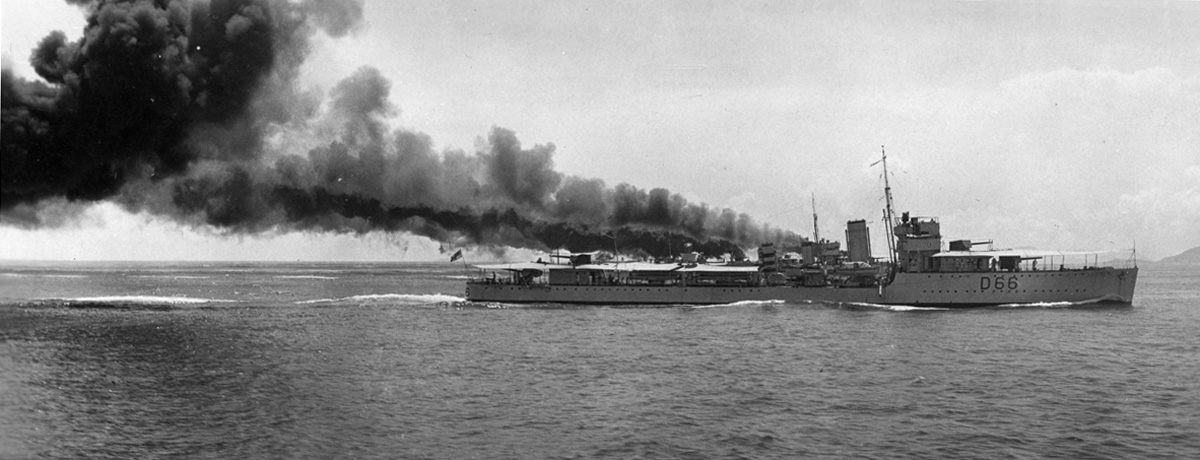
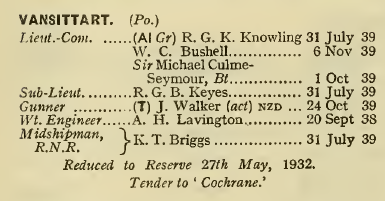 February 1940
|
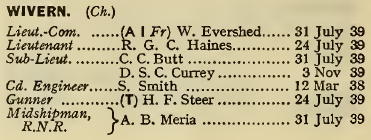 December 1939
On 17 January 1940 all the officers in HMS Wivern changed.
The new CO, Lt Cdr Bushell, Sub Lt Keyes, Warrant Officer Walker Gunner(T) and Mid Briggs were posted from HMS Vansittart |
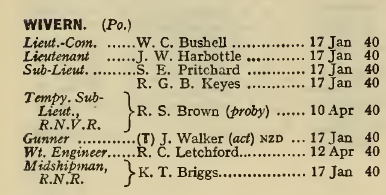 May 1940
|
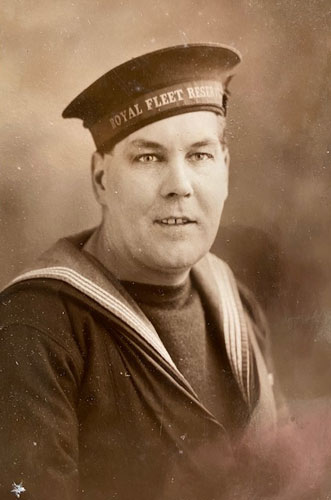 Reg Panton, Stoker (K59045)
|
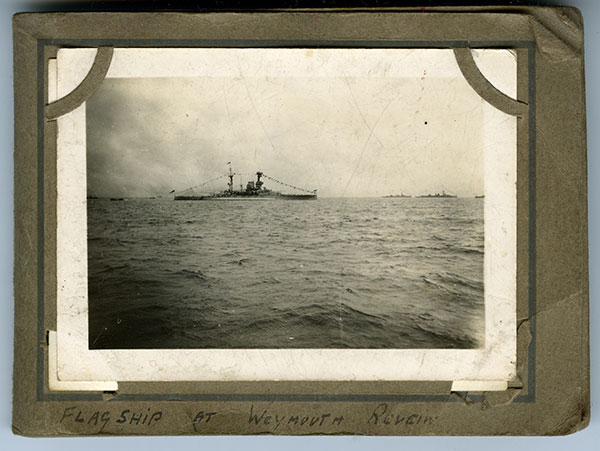 Page one of Reg Panton's Photograph Album: "Flag ship at Weymouth Review" |
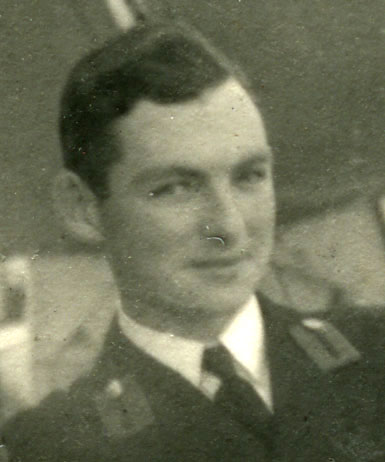 Midshipman Briggs
|
Pages two and three in Reg Panton's Album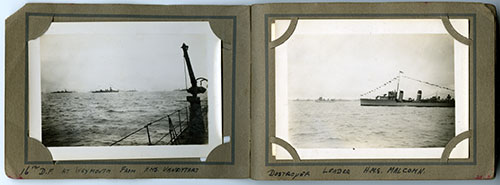 Left: "16 DF at Weymouth from HMS Vansittart" Right: "Destroyer Leader HMS Malcolm" |
|
Pages 14 to 15 in Reg Panton's Album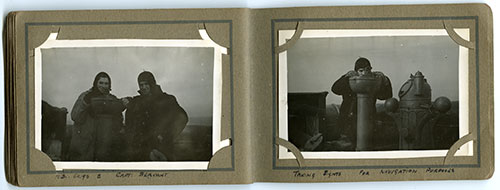 Left: "Mid Briggs and Capt. servant" Right: "Taking sights for navigation purpose" |
|
Pages four and five in Reg Panton's Album
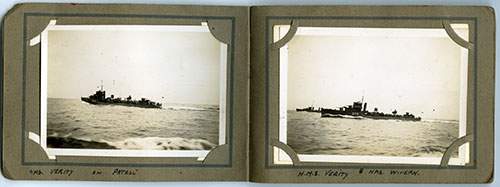 Left: "HMS Verity on patrol" Right: "HMS Verity and HMS Wivern" Error: Both photographs are of HMS Venomous (D75) not Verity |
Pages 16 to 17 in Reg Panton's Album
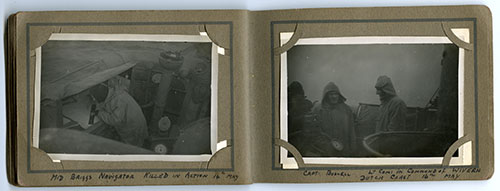 Left: "Mid Briggs Navigator Killed in Action 14th May" Right: "Captain William Charles Bushell, Lt Cdr in Command of Wivern Dutch Coast" |
|
Pages six to nine in Reg Panton's Album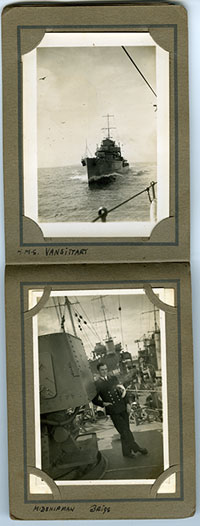 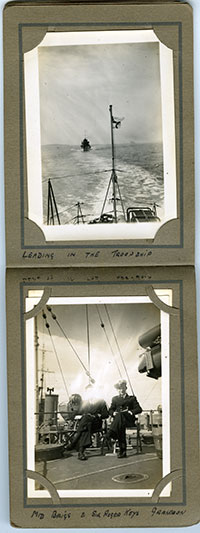 Left 6 & 7: "Vansittart" and "Midshipman Briggs" Right 8 & 9: "Leading in the Troopship" and "Sir Roger Keyes Grandson" (sic) |
Pages 18 to 19 in Reg Panton's Album 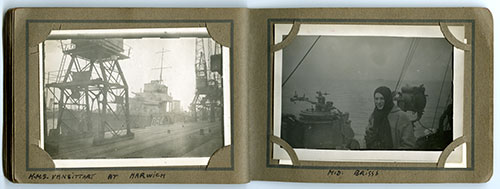 Left: "HMS Vansittart at Harwich" Right: "Mid Briggs" Pages 20 to 21 in Reg Panton's Album 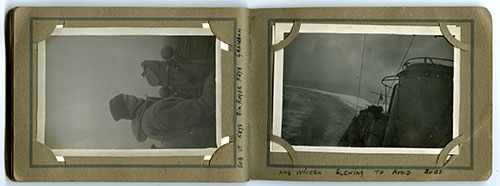 Left: "Sub Lt Keys Sir Roger Keys Grandson" Right: "Slewing to avoid subs" |
|
Pages ten to thirteen in Reg Panton's Album 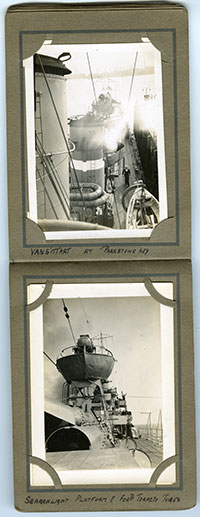 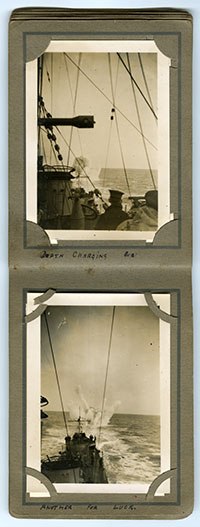 Left 10 & 11: "Vansittart at Parkstone Key" and "Searchlight Platform and for'd torpedo tubes" Right 12 & 13: "Depth charging" and "Another for luck" |
Pages 22 to 23 of Reg Panton's Album 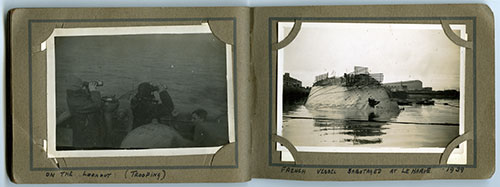 Left: "On the Lookout Trooping" Right: "French vessel bombed at Le Havre" Pages 24 to 25 of Reg Panton's Album 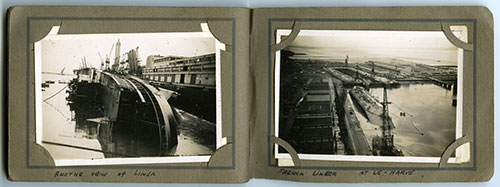 Left: "Another view of Liner" Right: "French Liner at Le Havre" |
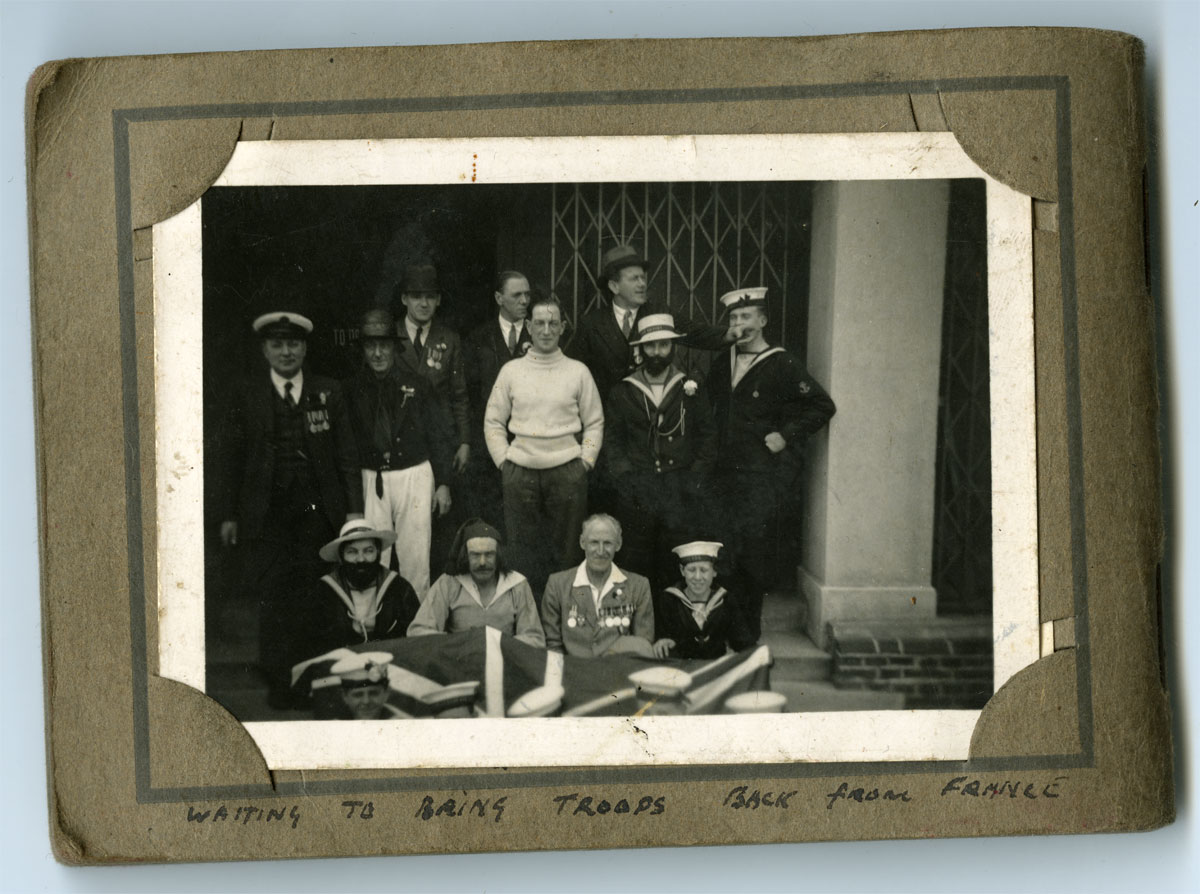
| SURNAME | FORENAME | RATE / RANK | CAUSE | ||
|---|---|---|---|---|---|
| ABRAMS |
FREDERICK |
AB |
P/J 110800 |
DOW |
|
| AIREY | ARTHUR | ERA5C | P/MX 61505 | KILLED | |
| BACKSHALL | FREDERICK | AB | P/SD/X 1328 | KILLED | |
| BAXTER | N | S | CHIEF ENGINE ROOM ARTICIFER | P/MX 47583 | WIA |
| BLACKBOROUGH | A | D | AB | WIA | |
| BLACKWELL | W | AB | WIA | ||
| BOYNTON | STANLEY | AB | P/SSX 31567 | KILLED | |
| BRIGGS | KENNETH | THEODORE | MIDSHIPMAN | RNR | KILLED |
| BROWN | RICHARD | STEPHEN | S/LT | RNVR | KILLED |
| CASSELL | JOHN | FREDERICK | PO | P/JX 136813 | DOW |
| CHING | ROBERT | JOHN LEWIS | AB | P/JX 143272 | WIA |
| CLEMENTS | F | W | PO | P/JX 127026 | WIA |
| CRAMMAN | ROBERT | PALLISTER | ERA2C | P/X 2873/EA | WIA |
| DUNNE | ALFRED | AB | D/SSX 122624 D 490 | MISSING | |
| ELLIOTT | T | L/STOKER | P/KX 76266 | WIA | |
| ELPHICK | OTTO | JAN HAMILTON | CHIEF PETTY OFFICER | P/J 53291 | WIA |
| FINDLAY | W | M | AB | P/X 19883 | WIA |
| FINNERTY | THOMAS | STEWARD | P/LX 22692 | KILLED | |
| GLOVER | G | C | AB | S/DX 1341 | WIA |
| GOUGH | E | A | PO | P/JX 135203 | WIA |
| GRAY | JOSEPH | STOKER1C | P/SS 120823 | KILLED | |
| GREENWOOD | JOHN | OD | P/SSX 32192 | KILLED | |
| HALLIDAY | EDWARD | STOKER1C | P/K 64869 | WIA | |
| HAMILTON | CHARLES | AB | P/JX 139840 | KILLED | |
| HANSELL | J | G | AB | P/JX 145423 | WIA |
| HARMAN | W | P | OD | S/DX 1179 | WIA |
| HAYDEN | FREDERICK | WILLIAM | AB | P/J 22737 | MISSING |
| HERRIDGE | THOMAS | HENRY | AB | P/JX 133933 | KILLED |
| HORTON | HERBERT | SAMUEL | STOKER1C | P/KX 84007 | DOW |
| LITTLE | ALFRED | BRITTON | STOKER2C | P/KX 100059 | DOW - 1/6/40 |
| MACDONALD | L | AB | P/X 9404/B | WIA | |
| MACIVER | MALCOLM | SEAMAN | P/X 19992/A | DOW - 16/5/40 | |
| MACLEAN | MURDO | SEAMAN | P/X 19703/A | KILLED | |
| MACLEOD | PETER | JOHN | SEAMAN | P/X 19754/A | KILLED |
| MAIR | J | AB | P/X 5754/B | WIA | |
| MANNING | EDWARD | COOK (S) | P/MX 52387 | DOW - 15/5/40 | |
| MAYNARD | WALTER | CHIEF PETTY OFFICER COOK | P/M 16148 | KILLED | |
| MEADEN | FREDERICK | AB | P/J 115219 | KILLED | |
| MOORE | FRANCIS | JOSEPH | PO STEWARD | P/L 3630 | KILLED |
| MORTIMER | REGINALD | JOSEPH | STOKER PO | P/K 98381 | DOW - 16/5/40 |
| PRITCHARD | SYDNEY | EVELYN | S/LT | RN | WIA |
| QUARRELL | ALFRED | FRANK | OFFICER'S COOK 2c | P/L 14554 | KILLED |
| RALPHSON | ROBERT | L/STOKER | P/KX 76360 | DOW - 15/5/40 | |
| ROWE | BERNARD | AB | P/J 89472 | WIA | |
| SAUL | S | AB | P/JX 125843 | WIA | |
| SMITH | ALFRED | ERA | P/X 973/BED | DOW - 23/5/40 | |
| SMITH | LESLIE | AB | P/SSX 29930 | KILLED | |
| SWEENEY | DANIEL | JOSEPH | STOKER2C | P/KX 104043 | MISSING |
| THOMPSON | GEORGE | LYALL | STOKER1C | D/KX 87321 | DOW - 19/7/40 |
| THORP | THOMAS | WILLIAM | PO | C/JX 135052 | WIA |
| WALSH | R | R | L/SEAMAN | P/JX 132915 | WIA |
| WELLFARE | JAMES | WILLIAM | AB | P/J 30102 | WIA |
| WOOD | THOMAS | REGINALD | AB | P/SD/X 898 | KILLED |